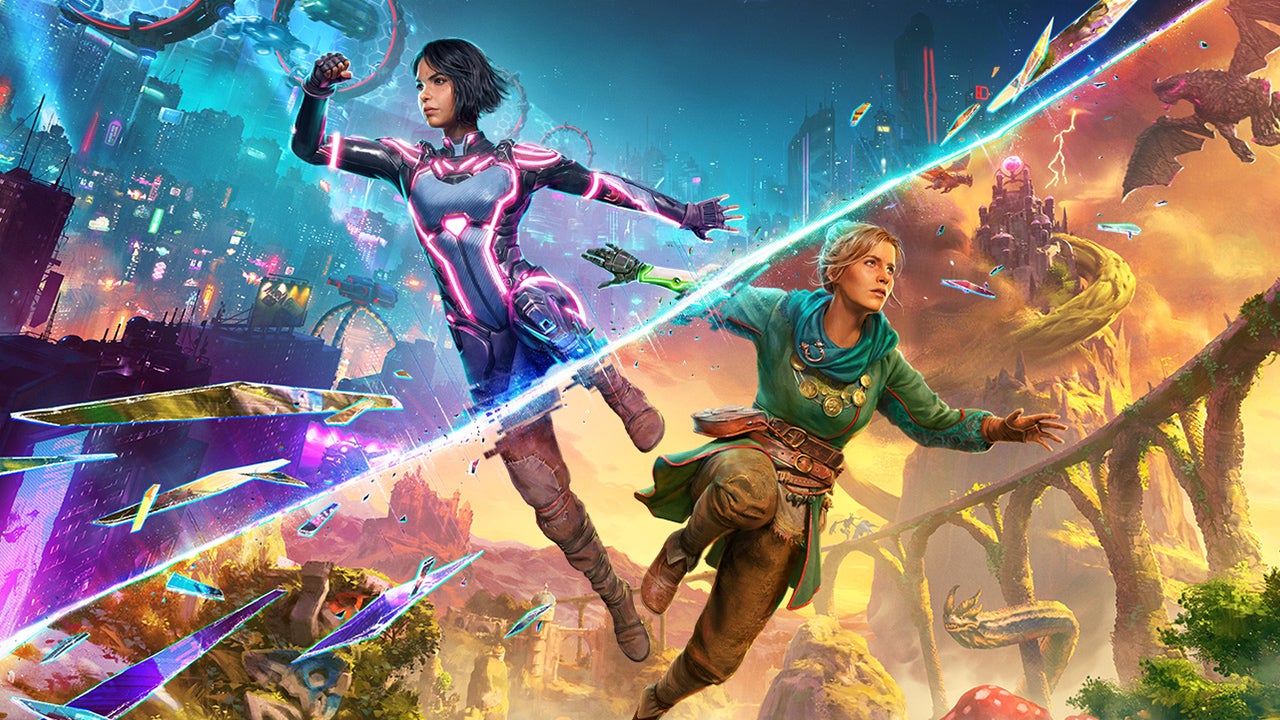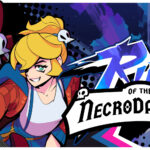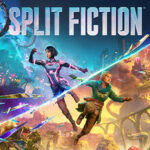After winning the Game of the Year gong for It Takes Two at the The Game Awards 2021 I’m certain that developer Hazelight Studios was positively brimming with ideas of what to do next. I’m certain of this because the team appears to have used every one of those ideas in Split Fiction. An enchanting and confident two-person adventure like no other, Split Fiction is non-stop, co-op satisfaction that had me smiling consistently as we progressed, parkoured, and pulverised our way through to one of the best finales I’ve ever played. Is it a puzzle platformer? Is it a third-person action adventure? Is it an extreme sports game, or a side-scroller, or a twin-stick shooter?
The answer is yes.
Split Fiction is the story of two young and unsuccessful authors, Zoe and Mio, lured to a mysterious tech company by the prospect of finally being published. What they didn’t count on, however, was having their brains strip mined of every story they’ve ever conceived. When a scuffle involving a suspicious Mio thrusts her into Zoe’s personal instance within the computer system, the two find themselves forced to work together to escape and foil the company’s plot. Zoe and Mio are quickly and effectively established as polar opposites in everything from their attitudes to their accents, but Split Fiction wastes little time tossing them together.
It’s an easy-to-grasp premise, and it’s almost baffling that it hasn’t come along in a dozen games already. That is, the idea of being trapped in an interactive, virtual world is a trope that’s been remixed repeatedly in film for decades. Of course, Split Fiction nonetheless arrives in 2025 as a particularly timely takedown of our grim future of being drenched in AI slop against our will. The fact that, at its heart, Split Fiction is two proud middle fingers to the conga line of entitled tech bros who’ve decided art is a commodity that can be scraped, stolen, and repackaged by their plagiarism engines only adds to its charm.
Non-friction
As with It Takes Two before it, Split Fiction’s platforming is immediately on point. With a jump, double-jump, and air dash at each character’s disposal, Split Fiction boasts the same high degree of aerial maneuverability as its predecessor. Wall runs can be spectacularly chained, grappling hooks are thrilling swings or slingshots, and rails, poles, and tiny landing spots have a soft lock that draws Zoe and Mio onto them – so long as you’ve pointed them largely in the right direction.
The upshot is a movement system that’s extremely approachable and easy to become adept with quite fast, and one that focuses on momentum and timing rather than getting too bogged down punishing tiny mistakes or a lack of expert-level finesse. It’s like having just one bumper up in a bowling alley; it’s happy to give you a slight nudge in the right direction on occasion, but it’s not going to render you immune from making mistakes entirely.
My only real criticism of the platforming is that there are a few occasions where it becomes tricky to catch up after falling behind your partner, as one player hurtles ahead and the other gets stuck in a brief loop of dying and respawning trying to get back on track. It’s also a minor bugbear having both Zoe and Mio simply clipping through each other whenever they occupy the same space, as it results in a surprisingly unfinished look. Make no mistake, having one character become an actual obstacle for the other would totally destroy the snappy pace of Split Fiction, but it would’ve looked so much better (and still made perfect sense) with some kind of digitised effect breaking up Zoe and Mio’s avatars whenever they found themselves perched on the same tiny platform.
At any rate, Split Fiction’s fast-paced platforming is perfect for its exclusively co-op approach, particularly when played by people of differing skill levels, as it’s mostly frictionless. Die outside of a boss battle and you’ll rapidly respawn near your partner automatically. Die within a boss battle and you can re-enter the fray after some brief button mashing. Checkpoints are generously frequent, even during boss fights. Chip their health down to halfway and you won’t need to repeat an encounter entirely, even if both Zoe and Mio are defeated at the same time. This is welcome because, as incredibly imaginative as the many bosses are, it’s not unusual to suffer a couple of cheap deaths during the fights – commonly after getting respawned under a salvo of deadly attacks that wipe you out the instant you blink back into existence. As such they were only ever brief setbacks, and we never had to repeat anything to the degree it felt like a chore.
Overall it’s not a particularly difficult game for, say, two dads with somewhere in the vicinity 80 years of video game literacy between them, but I don’t crave punishing difficulty and never have. For me Split Fiction soars thanks to its satisfying focus on communication, collaboration, and constant variety. It’s figuring out the path and the joy of suggesting the right puzzle solution. It’s laughing at untimely misunderstandings knowing the penalty for failure is never especially severe. It’s deciding whether to go on three, or if it’s one, two, three, GO! Split Fiction is nothing if not a game that makes you know what it would feel like to need your best friend to drag you off your booby-trapped toilet before it explodes. You’ve all seen Lethal Weapon 2, right? I did mention we’re a pair of 40-year-old dads, yeah?
Watching two of my kids play after I’ve finished it I’ve since seen a couple of possible bottlenecks (related to timing their way past a deadly obstacle) but if less experienced players have no one around to swoop in and save the day, the option to simply skip forward to the next checkpoint is available as a last resort. Split Fiction doesn’t want to stall anyone indefinitely. It wants to be played.
Clever, bending story
Split Fiction is so good at wanting to be played it’s hard to stop playing. It simply doesn’t stay the same long enough for it to ever become boring. If you’ve ever wondered whether it would be possible to squeeze SSX and Shadow of the Colossus into the same story, wonder no more. Split Fiction found a way.
Zoe and Mio are fantasy and sci-fi authors respectively, and the action is essentially divided equally between the two genres, but the fantasy and sci-fi branches of Split Fiction are anything but static. That is, the story doesn’t pendulum between a single sci-fi world and a single fantasy world repeatedly for 14-hours – the levels are always different, each with their own special hooks. Mio’s mental archive of sci-fi ideas range from a neon-splashed, futuristic city full of flying traffic – with gravity-defying cyber ninjas that will have you and a partner helping each other down a high-altitude highway while operating on totally different axes – to a space complex next to a dying star releasing pulsing blasts that will disintegrate Zoe and Mio if they’re caught out of cover. That’s just two, and I’m extremely hesitant to drill down on any more. Not knowing how each new level and side story will shake up the backdrop and the gameplay is a huge part of what makes Split Fiction such tremendous fun to scoot through.
Zoe’s fantasy worlds are initially a bit twee by comparison, and generally had me looking forward to the short sci-fi diversions that are scattered throughout, but they do feature the better boss battles (I’m reluctant to spoil the specifics of any of those either but, broadly speaking, the fantasy bosses are more impressive in size and have personalities than make them vastly more memorable). The fantasy portion does peak later in the story as it becomes a little darker and more grand-scale, which is a good springboard for the lengthy and meticulously engineered final level. It’s not just the most impressively executed stretch of Split Fiction overall; it’s one of the most memorable finales I’ve ever played. Split Fiction is a fine-looking game throughout, but the spectacle of the entire ending segment is a real visual victory for Hazelight.



